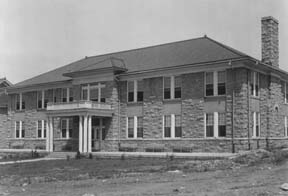The story is nothing new. It’s been repeated to the point of becoming a constant in James Madison University’s long history:
Needing a new building or program for students but lacking the necessary funds, the institution’s president asks the alumni for help.
Time and time again, the University’s alumni and friends have risen to the occasion and been the catalyst to create the change needed to lead JMU on to ever greater accomplishments.
In recent years, some of JMU’s finest facilities – including Showker Hall, the Plecker Athletic Performance Center and the soon-to-be built Performing Arts Complex – all owe their existence to the generous support of alumni and friends.
The tradition of JMU alumni and friends stepping forward goes back a long way.
Nearly 80 years ago, President Samuel P. Duke needed money for a new building so he turned to the alumnae of the State Normal School for what would become the institution’s first capital campaign.
Duke’s idea was for an Alumnae-Students’ Building on the north side of the Quadrangle. He outlined his plans to an alumnae luncheon at the Hotel Richmond on November 26, 1920. (A reunion luncheon for Normal School faculty and alumnae was held annually during the State Teachers Association conference.)
President Duke proposed that the alumnae sponsor a fund-raising drive to raise $50,000 for the construction of the new building that would contain rooms for student organizations, a reception room for social events and guest rooms for alumni and visitors.
In his book, Madison College, the First Fifty Years: 1908-1958, Dr. Raymond C. Dingledine Jr. pointed out that “the 121 alumnae present enthusiastically and unanimously endorsed the plan.”
The alumnae went into action with vigor. Committees were appointed throughout the state and individual graduates were asked to contribute to the drive.
The Harrisonburg and Staunton alumnae raised $175 by presenting the Staunton Military Academy Minstrel Show at Harrisonburg’s New Virginia Theatre. Norfolk alumnae opened the Cinderella Tea Room, where alumnae served as waitresses to raise money for the fund drive.
A team of alumnae played – and won – a benefit basketball game in Richmond against the alumnae of Farmville Normal School (now Longwood University). Tidewater graduates presented a play and other groups held card parties and food sales to raise money.
Back in Harrisonburg, President Duke rallied the campus and local communities. Business leaders raised more than $5,000. The Normal School faculty and students raised more than $2,000 each – even though enrollment was only 375 and there were fewer than 30 faculty members.
By 1921, enough money had been raised to begin construction. In June, a festive cornerstone-laying ceremony was a feature of the Commencement program.
Walls for the new building were completed by November but then the money ran out. The project was put on hold until Duke could find a way to raise the additional funds.
Despite their good intentions, the alumnae’s fund drive had raised only $12,550. The contributions were augmented by a $20,000 allocation Duke received from the General Assembly and $11,700 he transferred from operating funds.
The new Alumnae Hall was ready for use by the Summer Session of 1922. Duke, however, faced a problem that summer which would be shared by his successors – not enough room for student housing. The use of the second floor for guest quarters and student organizations had to be put on hold. The space was converted into rooms for about 30 students.

The construction of Alumnae Hall serendipitously led to a trademark feature on campus and a long-standing Madison legend. Grading on the Quadrangle for the building unearthed an enormous limestone rock. The cost of removing the huge stone would have been prohibitive so the top part of the stone was left untouched and protruding from the ground.
In the 1920s, Normal School students were not allowed to be seen in the company of young men without a dorm mother present. So they would have the time and privacy to kiss goodnight, a couple would hide behind the big rock and make out.
The legend expanded to include the prediction that the person you kiss at Kissing Rock will be the person you marry. There are no statistics on the prediction’s accuracy – or inaccuracy.
